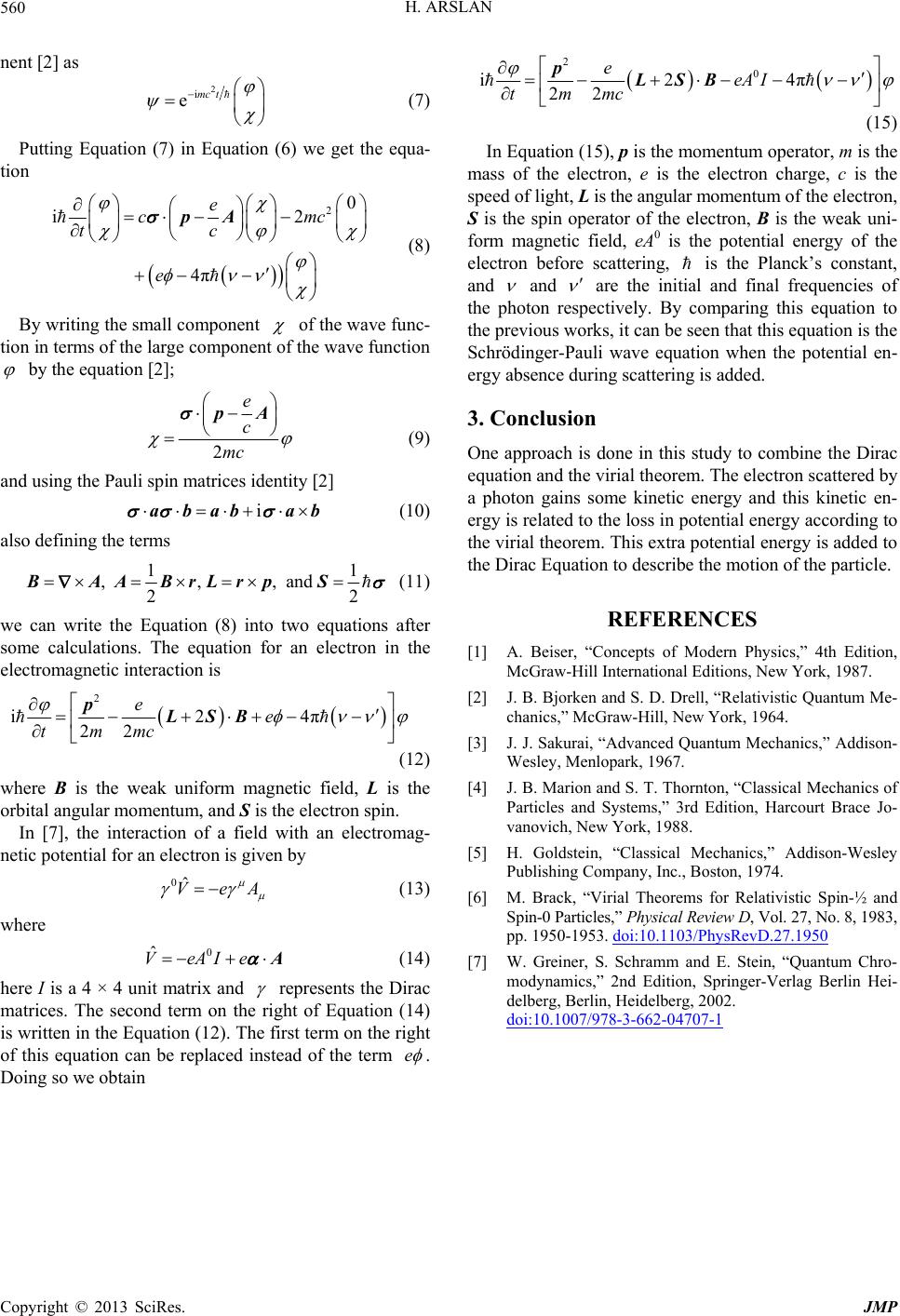
H. ARSLAN
560
nent [2] as
2
i
emc t
(7)
Putting Equation (7) in Equation (6) we get the equa-
tion
i
4π
e
c
tc
e
20
2mc
pA
(8)
By writing the small component
of the wave func-
tion in terms of the large component of the wave function
by the equation [2];
2
e
c
mc
pA
iab ab
(9)
and using the Pauli spin matrices identity [2]
ab
(10)
also defining the terms
1
, , , a
2
BAABrLr1
nd 2
pS
(11)
we can write the Equation (8) into two equations after
some calculations. The equation for an electron in the
electromagnetic interaction is
2
i2
22
ee
tmmc
4π
pLSB
0ˆ
VeA
(12)
where B is the weak uniform magnetic field, L is the
orbital angular momentum, and S is the electron spin.
In [7], the interaction of a field with an electromag-
netic potential for an electron is given by
0
AIe A
(13)
where
ˆ
Ve (14)
here I is a 4 × 4 unit matrix and
represents the Dirac
matrices. The second term on the right of Equation (14)
is written in the Equation (12). The first term on the right
of this equation can be replaced instead of the term e
.
Doing so we obtain
0
i24π
22 eA I
tmmc
2e
LSB
(15)
In Equation (15), p is the momentum operator, m
m
p
is the
ass of the electron, e is the electron charge, c is the
speed of light, L is the angular momentum of the electron,
S is the spin operator of the electron, B is the weak uni-
form magnetic field, eA0 is the potential energy of the
electron before scattering, is the Planck’s constant,
and
and
are the initial and final frequencies of
the poton reectively. By comparing this equation to
the previous works, it can be seen that this equation is the
Schrödinger-Pauli wave equation when the potential en-
ergy absence during scattering is added.
3. Conclusion
h sp
in this study to combine the Dirac
REFERENCES
[1] A. Beiser, “Csics,” 4th Edition,
e-
ics,” Addison-
nton, “Classical Mechanics of
echanics,” Addison-Wesley
tic Spin-½ and
One approach is done
equation and the virial theorem. The electron scattered by
a photon gains some kinetic energy and this kinetic en-
ergy is related to the loss in potential energy according to
the virial theorem. This extra potential energy is added to
the Dirac Equation to describe the motion of the particle.
oncepts of Modern Phy
McGraw-Hill International Editions, New York, 1987.
[2] J. B. Bjorken and S. D. Drell, “Relativistic Quantum M
chanics,” McGraw-Hill, New York, 1964.
[3] J. J. Sakurai, “Advanced Quantum Mechan
Wesley, Menlopark, 1967.
[4] J. B. Marion and S. T. Thor
Particles and Systems,” 3rd Edition, Harcourt Brace Jo-
vanovich, New York, 1988.
[5] H. Goldstein, “Classical M
Publishing Company, Inc., Boston, 1974.
[6] M. Brack, “Virial Theorems for Relativis
Spin-0 Particles,” Physical Review D, Vol. 27, No. 8, 1983,
pp. 1950-1953. doi:10.1103/PhysRevD.27.1950
[7] W. Greiner, S. Schramm and E. Stein, “Quantum Chro-
modynamics,” 2nd Edition, Springer-Verlag Berlin Hei-
delberg, Berlin, Heidelberg, 2002.
doi:10.1007/978-3-662-04707-1
Copyright © 2013 SciRes. JMP